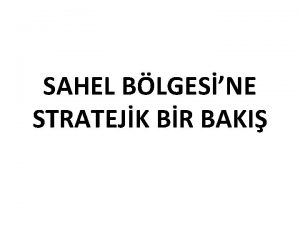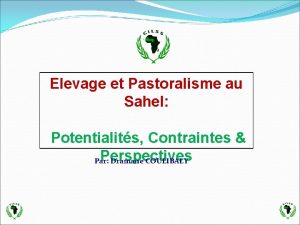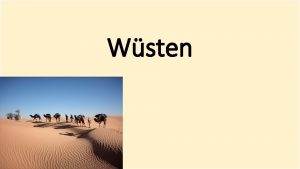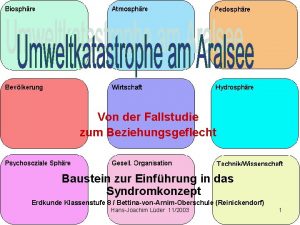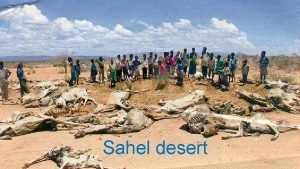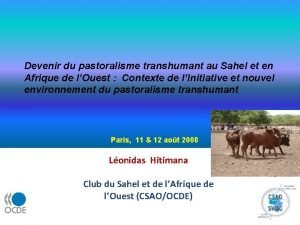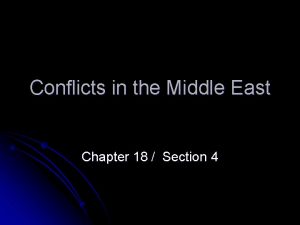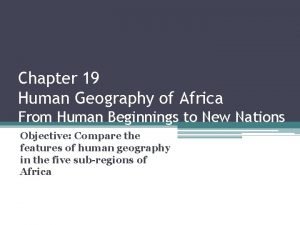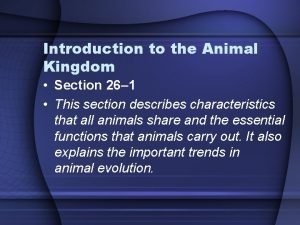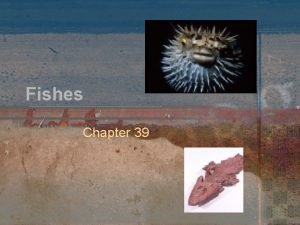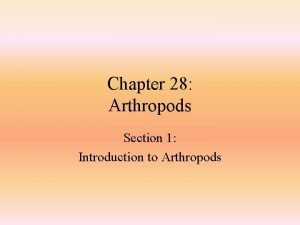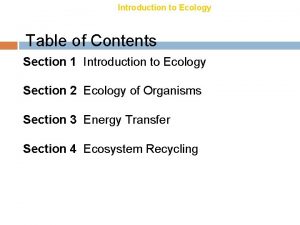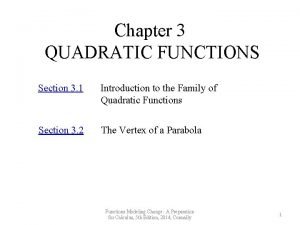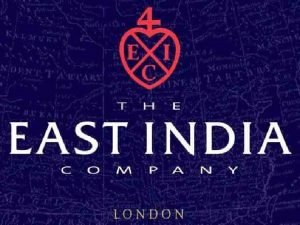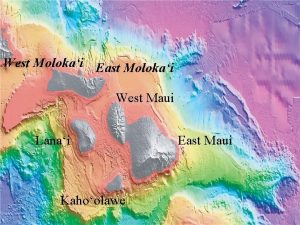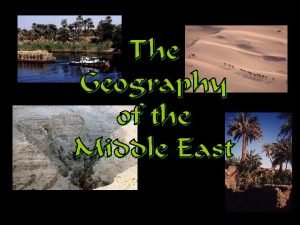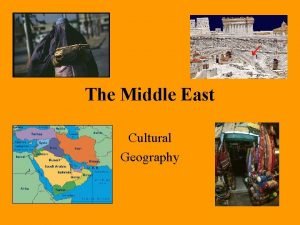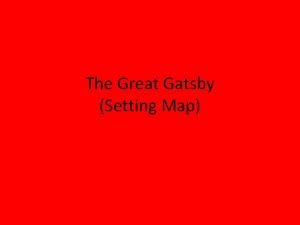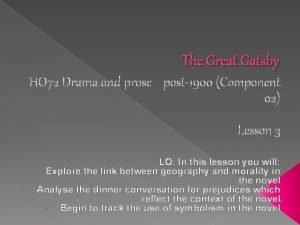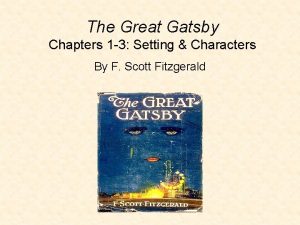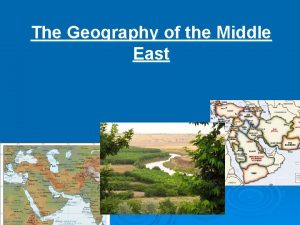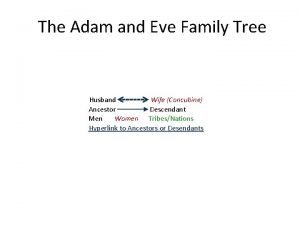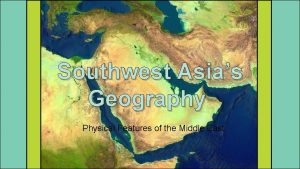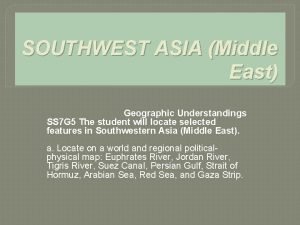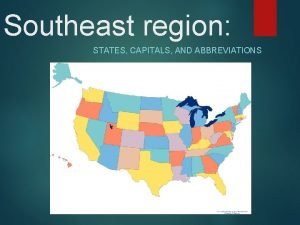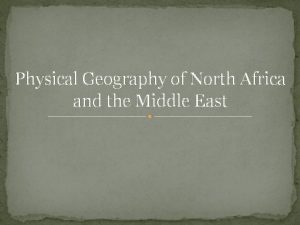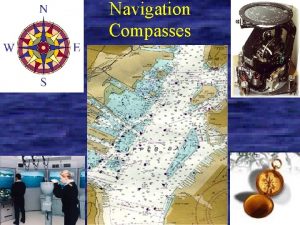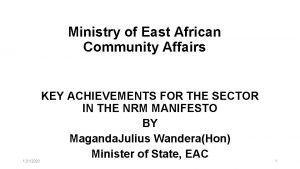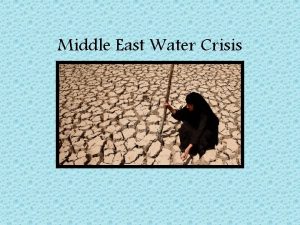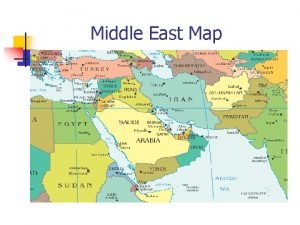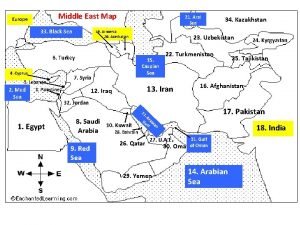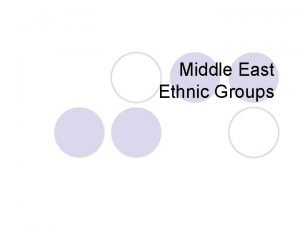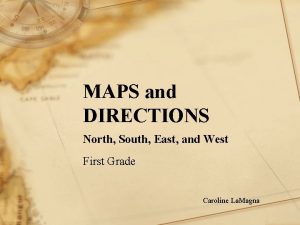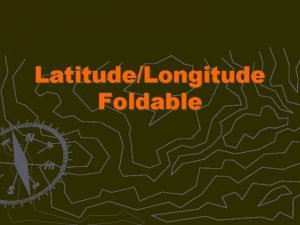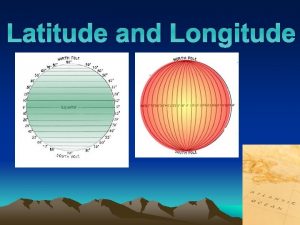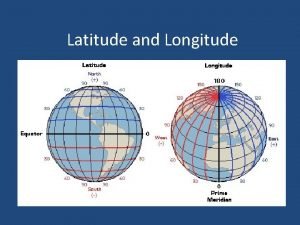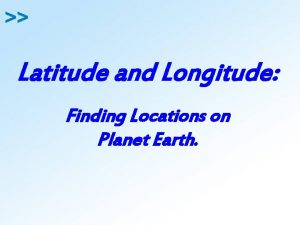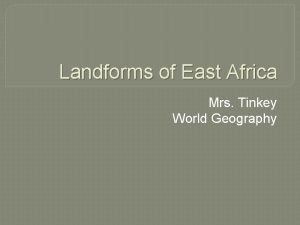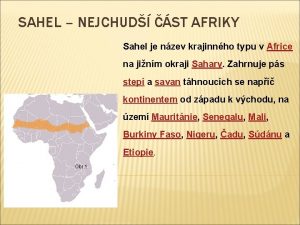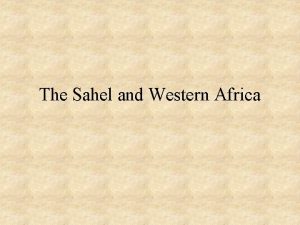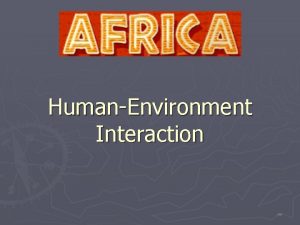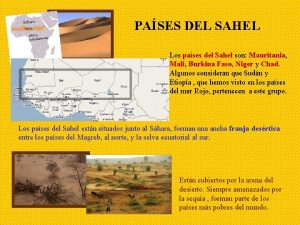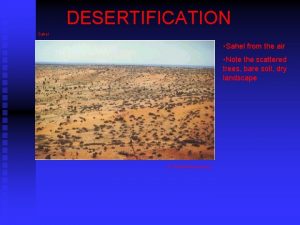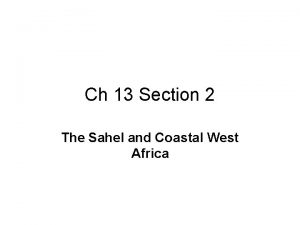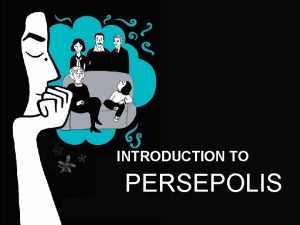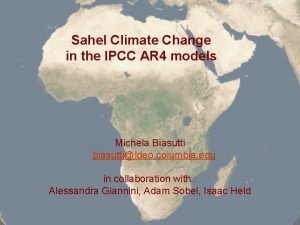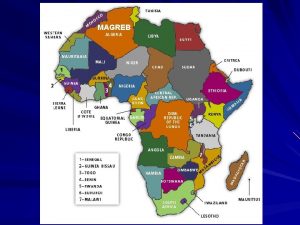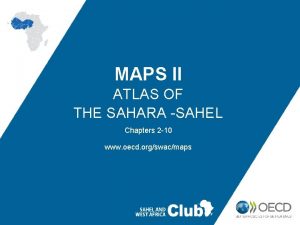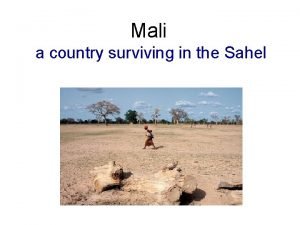Introduction Section 1 The Sahel Section 2 East
























































































































- Slides: 120


Introduction Section 1: The Sahel Section 2: East Africa Section 3: West Africa Section 4: Central Africa Section 5: Southern Africa Visual Summary

Current events in Africa south of the Sahara can best be understood by knowing about the region’s diverse peoples, its histories, and its cultures.

Section 1: The Sahel Places reflect the relationship between humans and the physical environment. The Sahel, at the edge of the Sahara, influences the ways of life in this subregion.

Section 2: East Africa Places reflect the relationship between humans and the physical environment. East Africa’s peoples, history, and cultures have been influenced by its location on the Atlantic coast.

Section 3: West Africa The characteristics and distribution of cultures influence human systems. West Africa’s religions and social structures play a major role in people’s daily lives.

Section 4: Central Africa Culture influences people’s perceptions of places and regions. While indigenous peoples built societies in response to the natural environment, European powers exploited the region.

Section 5: Southern Africa Geography is used to interpret the past, understand the present, and plan for the future. Knowledge of southern Africa’s natural resources and colonial past helps one fully know the region.


The Sahel, at the edge of the Sahara, influences the ways of life in this subregion.

The Sahel • indigenous • clan • domesticate • nuclear family • oral tradition • sanitation • patriarchal • survived • displaced • adequate

The Sahel A. Chad B. Senegal C. Mali D. Niger E. Sudan F. Kush G. Axum H. Mali Empire I. Songhai J. Timbuktu K. Darfur

The Sahel Are you familiar with the Sahel area? A. Very familiar B. Somewhat familiar C. Not familiar A. A B. B C. C

Population Patterns The changing physical environment and the many diverse ethnic groups have shaped population patterns in the Sahel. • The people: – Mandé people of Senegal and Mali – Wolof of Senegal

Population Patterns (cont. ) – Hausa of Niger – Fulani – Berber

Population Patterns (cont. ) • Density and distribution: – Population density is unevenly distributed. – Average population density is about 103 people per square mile. – Sudan has the highest density. Muslim Population

The average level of urbanization in the Sahel countries is what percentage? A. 25% B. 32% C. 45% D. 57% A. B. C. D. A B C D

History and Government The physical environment and the relative location of the Sahel have drawn together diverse cultures that continue to influence the subregion. • First civilizations: – Egyptian civilization – The kingdom of Kush

History and Government (cont. ) • Empires and colonization: – The Mali Empire – Songhai Empire – Complete European control by 1914 – Colonies gained independence by 1950 s African Kingdoms and Empires

History and Government (cont. ) • Sudan today—a division: – North—Arab-speaking Muslims; Islamicoriented government – South—live in rural areas; subsistence economy; secular government

How did Europe first become involved with Africa? A. Slave trade B. Trading goods C. Tourism D. Mission work A. B. C. D. A B C D

Culture Although diverse, the cultures of the Sahel region share many similarities. • The arts—African art—often expressing traditional religious beliefs—comes in many forms, from ritual masks to rhythmic drum music to folktales. • Family life—strong family ties valued.

Culture (cont. ) • Language—several African language groups: Afro -Asiatic, Nilo-Saharan, Congo-Kordofanian • Religion—Islam • Education—low school enrollment and literacy rates • Health care—poor health care

Are most families in this region patriarchal or matriarchal? A. Patriarchal B. Matriarchal A. A B. B


East Africa’s peoples, history, and cultures have been influenced by its location on the Atlantic coast.

East Africa • lingua franca • emerged • purchase

East Africa A. Uganda B. Tanzania C. Rwanda D. Burundi E. Kenya F. Ethiopia G. Somalia H. Djibouti I. Eritrea J. Dar es Salaam K. Dodoma

East Africa Which ocean has highly influenced the lives of people in East Africa? A. Atlantic B. Pacific C. Indian D. Mediterranean A. B. C. D. A B C D

Population Patterns The populations of East Africa have been shaped by their location along the long coast-line of the Indian Ocean. • In East African countries today, one ethnic group is the majority in a country.

Population Patterns (cont. ) • The people: – The Bantu—Uganda and Tanzania – Hutu—Rwanda and Burundi

Population Patterns (cont. ) • Density and distribution: – Distribution is highly uneven due to land climate. – City dwellers, nomads, and farmers live in this region. Africa South of the Sahara: Population Density

Which of the following contribute to East Africa’s problem with feeding its population? A. Soaring population growth B. Economic challenges C. Actions of governments and farmers D. Droughts E. All of the above A. B. C. D. E. A B C D E

History and Government Throughout much of its history, East Africa’s location has attracted people from many continents. • Early peoples and kingdoms: – Possible place of origin for all humankind – Kingdom of Axum – Djibouti people

History and Government (cont. ) – Arab traders – Persians • European colonization: – Britain, France, Germany, Portugal – British doctor and missionary David Livingstone

History and Government (cont. ) • Colonialism created enormous problems for Africa’s people. • European powers granted colonies independence in the 1960 s. • However, the newly independent countries faced (and still face) internal and external strife.

The Europeans divided Africa into how many different countries? A. More than 20 B. More than 30 C. More than 40 D. More than 50 A. B. C. D. A B C D

Culture Common elements such as language and religion connect the cultures of East Africa. • Language—Congo-Kordofanian, Nilo-Saharan, Afro. Asiatic; English and French • Religion—Christian or Muslim • Education—levels of education vary throughout the region; few complete secondary education.

Culture (cont. ) • Health care—many problems exist. • The arts—visual arts of masks and textiles; forms of music, dance, and oral traditions • Ways of life in East Africa are as varied as the ethnic groups who live there.

What is the most common language in Sudan and Eritrea? A. French B. Yoruba C. Arabic D. Portuguese A. B. C. D. A B C D


West Africa’s religions and social structures play a major role in people’s daily lives.

West Africa • urbanization • service centers • route • seeking • legal

West Africa A. Guinea B. Côte d’lvoire C. Togo D. Benin E. Nigeria F. Niger G. Gambia H. Senegal I. Ghana J. Mali K. Mauritania

West Africa Challenges that West Africa faces include which of the following? A. Negative population growth B. Ethnic conflict C. Agriculture A. A B. B C. C

Population Patterns The location and densities of West Africa’s populations affect people’s way of life. • The people: – Hausa – Yoruba

Population Patterns (cont. ) • Density and distribution: – Distribution is very uneven, with most people living along the coast and river plains. – Africa’s rate of urbanization is the world’s fastest (although only 44% live in cities). Urbanization in West Africa

More West Africans are moving to the city for what reason? A. Better jobs B. Public services C. Health care D. All of the above A. B. C. D. A B C D

History and Government West Africa’s history has been shaped by indigenous and outside forces, each with their own cultures. • Early empires: – Ghana Empire – Mali Empire

History and Government (cont. ) • The colonial era: – 1400 s—Portuguese set up trading posts along the African coast. – 1600 s and 1700 s—Europeans were actively trading with Africans, including slaves. – French colonizers were trying to end slavery during this time as well.

Which colony did the British form from several smaller ethnic territories in 1914? A. Ghana B. Mali C. Nigeria D. Timbuktu A. B. C. D. A B C D

Culture West African culture has been shaped by hundreds of years of European and Arab influences. • Language—hundreds of languages are spoken; English, French, Arabic, Yoruba • Religion—Islam, Christianity, traditional African religions • Education—inconsistent throughout the region

Culture (cont. ) • Health care—uneven and limited • The arts—music and dance, weaving, masks, sculptures

What kind of range is found in literacy rates in this region? A. 5– 40% B. 18– 75% C. 25– 60% D. 50– 80% A. B. C. D. A B C D


Central Africa While indigenous peoples built societies in response to the natural environment, European powers exploited the region.

Central Africa • pidgin • migrated • transport

Central Africa A. Democratic Republic of the Congo B. Cameroon C. Central African Republic D. Gabon E. Equatorial Guinea F. Bioko H. Senegal G. São Tomé and Príncipe I. Ghana

Central Africa Which of the following covers more than half of Central Africa? A. Mountains B. Rainforest C. Rivers D. Lakes A. A B. B C. C D. D

Population Patterns Groups of people throughout Central Africa usually have a shared culture, depending on where they live. • The people: – This region is home to hundreds of ethnic groups. – Most people exist by subsistence agriculture or raising cattle.

Population Patterns (cont. ) – Fulani – Bantu – Fang – Mbuti

Population Patterns (cont. ) • Density and distribution: – This region is the least densely populated on the continent. – More densely populated areas are in the Republic of the Congo, Cameroon, and the Democratic Republic of the Congo.

Which country has the most densely populated area? A. Republic of the Congo B. Cameroon C. Democratic Republic of the Congo D. Central African Republic A. A B. B C. C D. D

History and Government Central Africa was the location of early migrations and, later, of European systems of slavery, colonization, and plantation economies. • Early settlement: – Bantu-speaking people established settlements in the region by A. D. 800.

History and Government (cont. ) • Slavery: – Huge numbers of people from the African interior were sold into slavery. The Atlantic Slave Trade

History and Government (cont. ) • European colonization: – It was not until the 1800 s that large areas of Central Africa were colonized. – By 1960, all the French colonies had become independent countries.

History and Government (cont. ) • Instability after independence: – People in most Central African countries experienced periods of ethnic strife, harsh rule, and human rights abuses after independence.

How did France gain control of the Republic of the Congo in the late 1800 s? A. Promising protection from Belgium B. Enslaving the people C. Providing food and water D. Defeating the king A. A B. B C. C D. D

Culture The many diverse cultures of Central Africa share similar experiences as a result of geography, their history, and their current situation. • Language— 700 local languages in the Democratic Republic of the Congo alone; French; pidgin • The arts—Mangbetu pottery, sculpture

Culture (cont. ) • Religion and family life are intertwined—numerous and diverse religions, but they share many common elements. • Some Christianity found as well. • Education—many systems are strained. • Health care—this is also strained in most areas.

Which of the following are primary health care concerns for Central Africa? A. Lack of safe drinking water B. Shortage of vaccines for curable diseases C. Rising number of AIDS victims D. All of the above A. A B. B C. C D. D


Southern Africa Understanding southern Africa’s natural resources and colonial past helps one fully know the region.

Southern Africa • coup d′état • apartheid • civil • denied • universal suffrage

Southern Africa A. Zambia B. Zimbabwe C. Malawi D. Mozambique E. Swaziland F. South Africa G. Namibia H. Lesotho I. Johannesburg J. Madagascar K. Angola M. Botswana L. Comoros N. Mauritius

Southern Africa The San people of South Africa depend on what for their survival? A. Livestock B. Farming C. Hunting/gathering D. Business A. A B. B C. C D. D

Population Patterns Southern Africa is undergoing significant population changes as a result of its colonial history and present challenges. • The people: – Sena – Bantu – Swazi

Population Patterns (cont. ) – Zulu – San – Afrikaners Ethnic Composition of South Africa

Population Patterns (cont. ) • Density and distribution: – Population densities vary widely across the region. – Many people are moving to urban areas to work in gold and diamond mines. – Despite population explosions in parts of Africa, AIDS is expected to reduce the populations of many of the region’s countries. The State of HIV/AIDS

How much of Africa’s population south of the Sahara will live in cities by 2030? A. A quarter B. More than one-third C. More than half D. Three-fourths A. A B. B C. C D. D

History and Government Situations created by colonial rule challenge southern Africa today and will continue to do so into the future. • Early cultures: – Zulu – Bantu

History and Government (cont. ) • European colonization: – Arabs and Europeans settled in southern Africa for economic reasons. – The Portuguese controlled Angola, Mozambique, Comoros, and Mauritius.

History and Government (cont. ) • Challenges after independence: – Postcolonial rule has been a difficult adjustment for most African countries. – Exceptions—Botswana, Mauritius – Apartheid was ended in the early 1990 s, but problems continue today.

Who was the first black president of South Africa? A. Nzinga Mbemba B. Mobutu Sese C. Nelson Mandela D. Paul Solopek A. A B. B C. C D. D

Culture While countries in southern Africa enjoy more freedoms under independence, they face serious economic and health-care problems. • Language—African languages; English, French, Afrikaans • Religion—Christianity as well as traditional religions

Culture (cont. ) • Education—since independence, higher education has expanded. • Health care—AIDS has reached epidemic proportions and most can’t afford drug treatments. • The arts—indigenous crafts, music, and dancing • Leisure—playing games and spending time with family

City dwellers often wear Western-style clothing, use cell phones, and watch television. A. True B. False A. A B. B


Population Patterns • Africa south of the Sahara has the world’s highest birthrates and death rates. • The high death rate is the result of poverty, disease, and conflict. • Despite high death rates, the population of Africa south of the Sahara is growing faster than any other region of the world.

Urban Growth • Although Africa south of the Sahara is one of the least urbanized regions of the world, it has the world’s fastest rate of urbanization. • Cities have better job opportunities, health care, and public services that attract people from rural areas. • Most cities in the region are built along the coast, along rivers, or in areas rich in natural resources. Almost all of the major cities began as centers of trade.

Historical Legacy • In its early history, Africa was home to major trading kingdoms, like Songhai, Ghana, Mali, Kush, and Axum. • As Europeans began exploring the globe, they traded with African rulers for gold and other goods. Later they also traded for enslaved people. • The European powers later divided Africa into colonies. They extracted resources and promoted European culture at the expense of traditional African ways.













The Shona were skilled builders and stonemasons, probably were very well organized, and had many workers and the ability to feed them.

indigenous native to a place

domesticate to adapt plants and animals from the wild to make them useful to people

oral tradition stories passed down from generation to generation by word of mouth

patriarchal relating to a social group headed by a male family member

clan tribal community or large group of people related to one another

nuclear family group made up of a husband, wife, and children

sanitation disposal of waste products

lingua franca a common language used among people with different native languages

urbanization the movement of people from rural areas into cities

service center convenient business location for rural dwellers

pidgin simplified speech used among people who speak different languages

coup d′état a violent overthrow of the government

apartheid policy of strict separation of the races adopted in South Africa in the 1940 s

universal suffrage equal voting rights for all adult citizens of a nation

To navigate within this Presentation Plus! product: Click the Forward button to go to the next slide. Click the Previous button to return to the previous slide. Click the Return button to return to the main presentation. Click the Home button to return to the Chapter Menu. Click the Help button to access this screen. Click the Exit button or press the Escape key [Esc] to end the chapter slide show. Links to Maps in Motion, static maps and charts, and transparencies appear near the bottom of slides as they are relevant. Links to the Reference Atlas and Geography Online are located on the navigation bar of most screens.

This slide is intentionally blank.
 Sahel bölgesi
Sahel bölgesi Locate
Locate Pastoralisme au sahel
Pastoralisme au sahel Aralsee syndrom definition
Aralsee syndrom definition Amurdarja
Amurdarja Sahel rainfall graph
Sahel rainfall graph Sahel desert location
Sahel desert location Pastoralisme au sahel
Pastoralisme au sahel How made vulnerable
How made vulnerable East south east wind direction
East south east wind direction Near east vs middle east
Near east vs middle east East is east and west is west
East is east and west is west Hình ảnh bộ gõ cơ thể búng tay
Hình ảnh bộ gõ cơ thể búng tay Slidetodoc
Slidetodoc Bổ thể
Bổ thể Tỉ lệ cơ thể trẻ em
Tỉ lệ cơ thể trẻ em Gấu đi như thế nào
Gấu đi như thế nào Chụp phim tư thế worms-breton
Chụp phim tư thế worms-breton Hát lên người ơi alleluia
Hát lên người ơi alleluia Kể tên các môn thể thao
Kể tên các môn thể thao Thế nào là hệ số cao nhất
Thế nào là hệ số cao nhất Các châu lục và đại dương trên thế giới
Các châu lục và đại dương trên thế giới Công thức tiính động năng
Công thức tiính động năng Trời xanh đây là của chúng ta thể thơ
Trời xanh đây là của chúng ta thể thơ Mật thư tọa độ 5x5
Mật thư tọa độ 5x5 101012 bằng
101012 bằng độ dài liên kết
độ dài liên kết Các châu lục và đại dương trên thế giới
Các châu lục và đại dương trên thế giới Thể thơ truyền thống
Thể thơ truyền thống Quá trình desamine hóa có thể tạo ra
Quá trình desamine hóa có thể tạo ra Một số thể thơ truyền thống
Một số thể thơ truyền thống Cái miệng nó xinh thế chỉ nói điều hay thôi
Cái miệng nó xinh thế chỉ nói điều hay thôi Vẽ hình chiếu vuông góc của vật thể sau
Vẽ hình chiếu vuông góc của vật thể sau Thế nào là sự mỏi cơ
Thế nào là sự mỏi cơ đặc điểm cơ thể của người tối cổ
đặc điểm cơ thể của người tối cổ Giọng cùng tên là
Giọng cùng tên là Vẽ hình chiếu đứng bằng cạnh của vật thể
Vẽ hình chiếu đứng bằng cạnh của vật thể Vẽ hình chiếu vuông góc của vật thể sau
Vẽ hình chiếu vuông góc của vật thể sau Thẻ vin
Thẻ vin đại từ thay thế
đại từ thay thế điện thế nghỉ
điện thế nghỉ Tư thế ngồi viết
Tư thế ngồi viết Diễn thế sinh thái là
Diễn thế sinh thái là Dạng đột biến một nhiễm là
Dạng đột biến một nhiễm là Số nguyên tố là
Số nguyên tố là Tư thế ngồi viết
Tư thế ngồi viết Lời thề hippocrates
Lời thề hippocrates Thiếu nhi thế giới liên hoan
Thiếu nhi thế giới liên hoan ưu thế lai là gì
ưu thế lai là gì Khi nào hổ mẹ dạy hổ con săn mồi
Khi nào hổ mẹ dạy hổ con săn mồi Khi nào hổ con có thể sống độc lập
Khi nào hổ con có thể sống độc lập Hệ hô hấp
Hệ hô hấp Từ ngữ thể hiện lòng nhân hậu
Từ ngữ thể hiện lòng nhân hậu Thế nào là mạng điện lắp đặt kiểu nổi
Thế nào là mạng điện lắp đặt kiểu nổi Chapter 18 section 4 conflicts in the middle east
Chapter 18 section 4 conflicts in the middle east Chapter 19 section 1 east africa
Chapter 19 section 1 east africa Chapter 19 section 1 europeans explore the east
Chapter 19 section 1 europeans explore the east Intro paragraph outline
Intro paragraph outline Circle vocab
Circle vocab Section 26-1 introduction to the animal kingdom
Section 26-1 introduction to the animal kingdom Section 22-1 introduction to plants answer key
Section 22-1 introduction to plants answer key 32-1 introduction to mammals answer key
32-1 introduction to mammals answer key Section 28-2 groups of arthropods
Section 28-2 groups of arthropods Section 39-1 review introduction to vertebrates
Section 39-1 review introduction to vertebrates 28-1 introduction to arthropods
28-1 introduction to arthropods Chapter 19 section 1 introduction to protists answer key
Chapter 19 section 1 introduction to protists answer key Section 18-1 introduction to ecology worksheet answers
Section 18-1 introduction to ecology worksheet answers Section 28-1 introduction to the arthropods
Section 28-1 introduction to the arthropods Section 3 introduction to functions
Section 3 introduction to functions Chapter 1 section 1 introduction to biology
Chapter 1 section 1 introduction to biology Section 1 introduction to geometry answers
Section 1 introduction to geometry answers Introduction to chemistry section 3 scientific methods
Introduction to chemistry section 3 scientific methods Chapter 24 section 1 animal characteristics
Chapter 24 section 1 animal characteristics East india company flag
East india company flag Picture of lanai
Picture of lanai A storm system moves 5000 km due east
A storm system moves 5000 km due east Collinear vectors example
Collinear vectors example Carl yaztremski
Carl yaztremski All states east of the mississippi river
All states east of the mississippi river Outer north east london
Outer north east london Middle east latitude and longitude
Middle east latitude and longitude Cultural geography of the middle east
Cultural geography of the middle east Gatsby east egg west egg map
Gatsby east egg west egg map West egg and east egg
West egg and east egg East egg and west egg
East egg and west egg Great gatsby summary chapter 9
Great gatsby summary chapter 9 Why is it called the middle east
Why is it called the middle east Adam and eve grandson
Adam and eve grandson Piney woods deposition
Piney woods deposition Weathering erosion and deposition in blackland prairie
Weathering erosion and deposition in blackland prairie East severna park swim league
East severna park swim league Renovation east youtube
Renovation east youtube East central indiana
East central indiana Chattisgarh is in east or west
Chattisgarh is in east or west Inlet of indian ocean between africa and asia
Inlet of indian ocean between africa and asia Jordan river on map
Jordan river on map Southeast capitals and abbreviations
Southeast capitals and abbreviations Orthopaedic services east london
Orthopaedic services east london East central consortium
East central consortium Pueblo gang
Pueblo gang The sun rise in the east simple present tense
The sun rise in the east simple present tense A proton moves eastward in the plane
A proton moves eastward in the plane Pilotage and dead reckoning
Pilotage and dead reckoning Physical features of the middle east map
Physical features of the middle east map Cumbria and north east ics
Cumbria and north east ics North canada provinces
North canada provinces Cdmvt aviation
Cdmvt aviation Ministry of east african community affairs uganda
Ministry of east african community affairs uganda Middle east countries and water
Middle east countries and water Middle east map
Middle east map Black sea on middle east map
Black sea on middle east map Ethnic groups in the middle east
Ethnic groups in the middle east North east west south map
North east west south map Angular distance latitude longitude
Angular distance latitude longitude Cehl:morv:wybf:
Cehl:morv:wybf: Northern and western hemisphere
Northern and western hemisphere Lines that run north and south
Lines that run north and south East west hemisphere
East west hemisphere Horizontal lines on a globe
Horizontal lines on a globe East west hemisphere
East west hemisphere Great rift valley on map
Great rift valley on map
